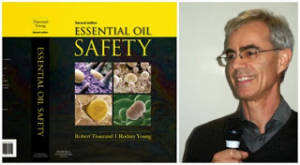
In just a few weeks the wait is over and we can finally read the first pages of Robert Tisserand’s much anticipated book “Essential Oil Safety – Second Edition”.
According to the preview on his website, “this new, thoroughly updated edition has been extended with new coverage and elaborated with greater detail and references to provide in depth, research-based coverage of both consequential new findings and newly tested past findings.”
The book will be available in mid October but Robert Tisserand was kind enough to give us some insight into his work prior to its official release:
1) What can our students expect from your updated Essential Oil Safety edition?
It is perhaps the first real textbook for aromatherapy students and practitioners, with full details of the chemistry and safety of 400 essential oils, and 780 pages of dense text.
2) A big and important topic in the aromatherapy community at the moment is “Phototoxicity”. What are the most common myths out there?
One of the most common myths in relation to phototoxicity is that certain oils are phototoxic when in fact they are not. These include cassia, cedarwood, cinnamon bark, ginger, lavandin, lavender, patchouli and sweet orange. However, bitter orange is phototoxic. There is also a myth that grapefruit oil is not phototoxic, when in fact it is phototoxic.
3) In your updated edition you also discuss the potential for interactions between essential oils and orthodox drugs for the first time. Can you tell us a bit more about this and why it is so important with regards to essential oil safety?
It is important because:
* The risk of essential oil / drug interactions has never before been looked at comprehensively
* Increasing numbers of people use essential oils and increasing numbers also use prescription drugs. So the risk of interaction must increase too
* Interactions can have serious consequences, such as seizures (from interaction with anticonvulsant medication) or internal hemorrhage (from interaction with blood-thinning medication)
* Some interactions can take place from non-oral dosing, notably with lemongrass oil or blue chamomile oil
* Also note that, in order to continue to develop our understanding of potential interactions, practitioner feedback is hugely important
Thanks so much, Robert – we are really looking forward to finally holding your second edition in our hands!
If you want to reserve your own copy of Robert Tisserand’s comprehensive guide, send us an email until end of September and enjoy a special pre-order discount. Read more details here!
